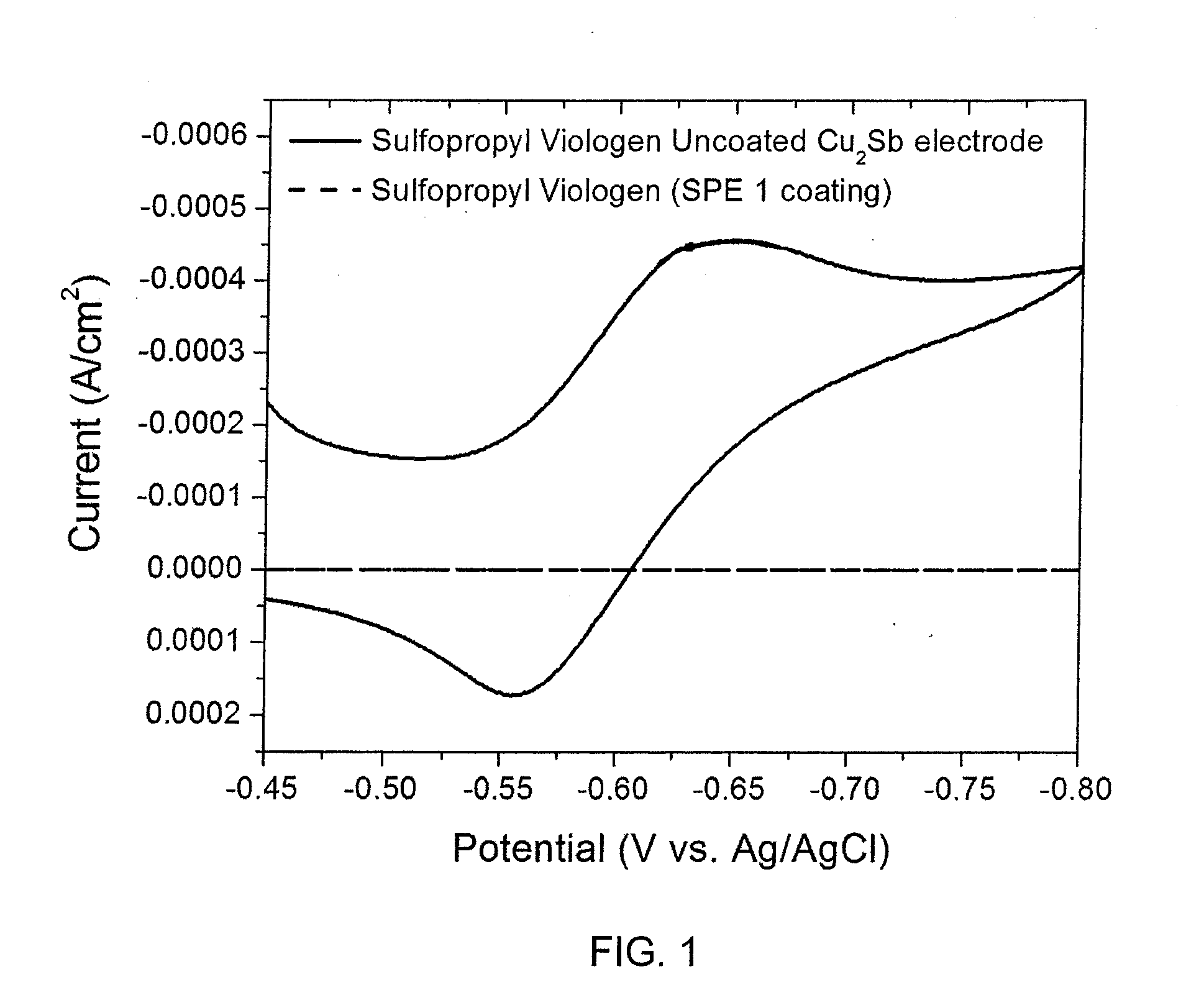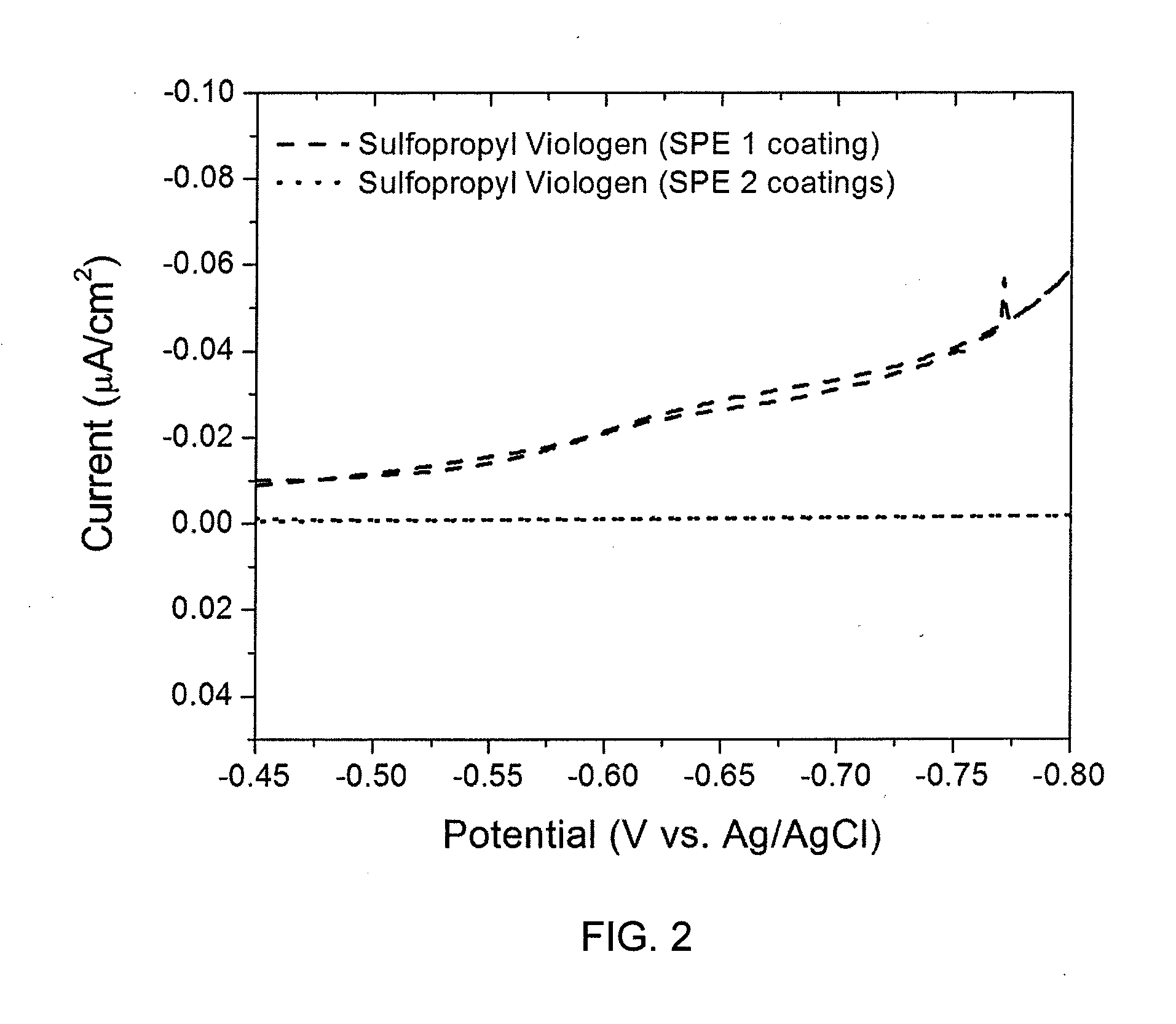Detection of defects in solid-polymer coatings using reduction-oxidation probes
a technology of solid-polymer coating and reduction-oxidation probe, which is applied in the direction of sustainable manufacturing/processing, cell components, instruments, etc., can solve the problems of unsatisfactory device performance, difficult to quantify the presence or absence of defects or pinholes in such three-dimensional architectures, and irreparable damage to both the coating and the energy storage devi
- Summary
- Abstract
- Description
- Claims
- Application Information
AI Technical Summary
Benefits of technology
Problems solved by technology
Method used
Image
Examples
example 1
Effect of Size on Permeation of Probe Species
[0035]Nondestructive, electrochemical evaluation of polyacrylonitrile-polymethyl acrylate copolymer film using the current response to an active reduction-oxidation (RedOx) probe is described. While data associated with the coating process demonstrates that a submicron-thick, solid polymer electrolyte (SPE) film comprising acrylonitrile and methyl acrylate has been deposited onto the Cu2Sb surface, it does not illustrate whether the solid polymer coating is free of pinholes, which would result in an internal short when a positive electrode is applied to complete a battery structure. The present nondestructive electrochemical RedOx evaluation utilizes water soluble sulfopropyl viologen and methyl viologen dichloride, both of which can reversibly accept and donate electrons at a potential more positive than the reduction of water and more negative than the oxidation potential of Cu2Sb. Sulfopropyl viologen is a neutral species that is sligh...
example 2
Attachment of an Effective Probe to a Nanoparticle
[0041]The redox active species, N-(1-heptyl, N′-(3-carboxypropyl)-4,4′-bipyridinium) bromide, HVP2+, was attached to the surface of titanium dioxide (TiO2) nanoparticles, as will be described hereinbelow. HVP2+ is a long-chain, redox-active organic molecule containing a carboxylic acid group at one end that can bind to metal oxide surfaces through Van der Waals type bonding, as illustrated in FIG. 5, hereof. The redox activity of HVP2+ is imparted by the incorporation of a dicationic 4,4′-bipyridinium moiety in the interior of the molecule that exhibits two one-electron redox couples at approximately −700 mV and −850 mV vs. Ag / AgCl. As shown in FIG. 6, hereof, attachment of HVP2+ to the surface of titania nanoparticles was accomplished by solvothermal decomposition of titanium isopropoxide, Ti(iPrO)4, in a solution of methanolic HVP2+ at 100° C. Following the removal of excess HVP2+ by precipitation with diethyl ether, the colloidal ...
example 3
Demonstration of Electrochemical Activity of Heterostructure
[0049]To demonstrate that the above described heterostructure is electrochemically active in the desired potential window, the electrochemical behavior of a 2 mM solution of free HVP2+ in 0.1 M HCl was analyzed using both a glassy carbon disk and Cu2Sb electrodeposited onto Cu foil as working electrodes. For each electrode, two redox couples were observed; a quasi-reversible event at E1 / 2=−0.63 V vs. Ag / AgCl and an irreversible reduction at Ep=−0.85 V vs. Ag / AgCl=50 mV / s). The potentials for the redox couples shift slightly upon attachment to a TiO2 nanoparticle. For a 9% (v / v) solution of HVP2+-TiO2 dispersion in 0.1 M HCl, the redox couples are observed at E1 / 2=−0.68 V and Ep=−0.85 V vs. Ag / AgCl=50 mV / s). When Cu2Sb is the working electrode, the potentials are E1 / 2=−0.64 V and Ep=−0.83 V vs. Ag / AgCl. As shown in FIG. 9, while attaching the HVP2+ species to the titanium dioxide nanoparticles results in a slight shift in th...
PUM
| Property | Measurement | Unit |
|---|---|---|
| volume | aaaaa | aaaaa |
| conductive | aaaaa | aaaaa |
| current | aaaaa | aaaaa |
Abstract
Description
Claims
Application Information
 Login to View More
Login to View More - R&D
- Intellectual Property
- Life Sciences
- Materials
- Tech Scout
- Unparalleled Data Quality
- Higher Quality Content
- 60% Fewer Hallucinations
Browse by: Latest US Patents, China's latest patents, Technical Efficacy Thesaurus, Application Domain, Technology Topic, Popular Technical Reports.
© 2025 PatSnap. All rights reserved.Legal|Privacy policy|Modern Slavery Act Transparency Statement|Sitemap|About US| Contact US: help@patsnap.com



